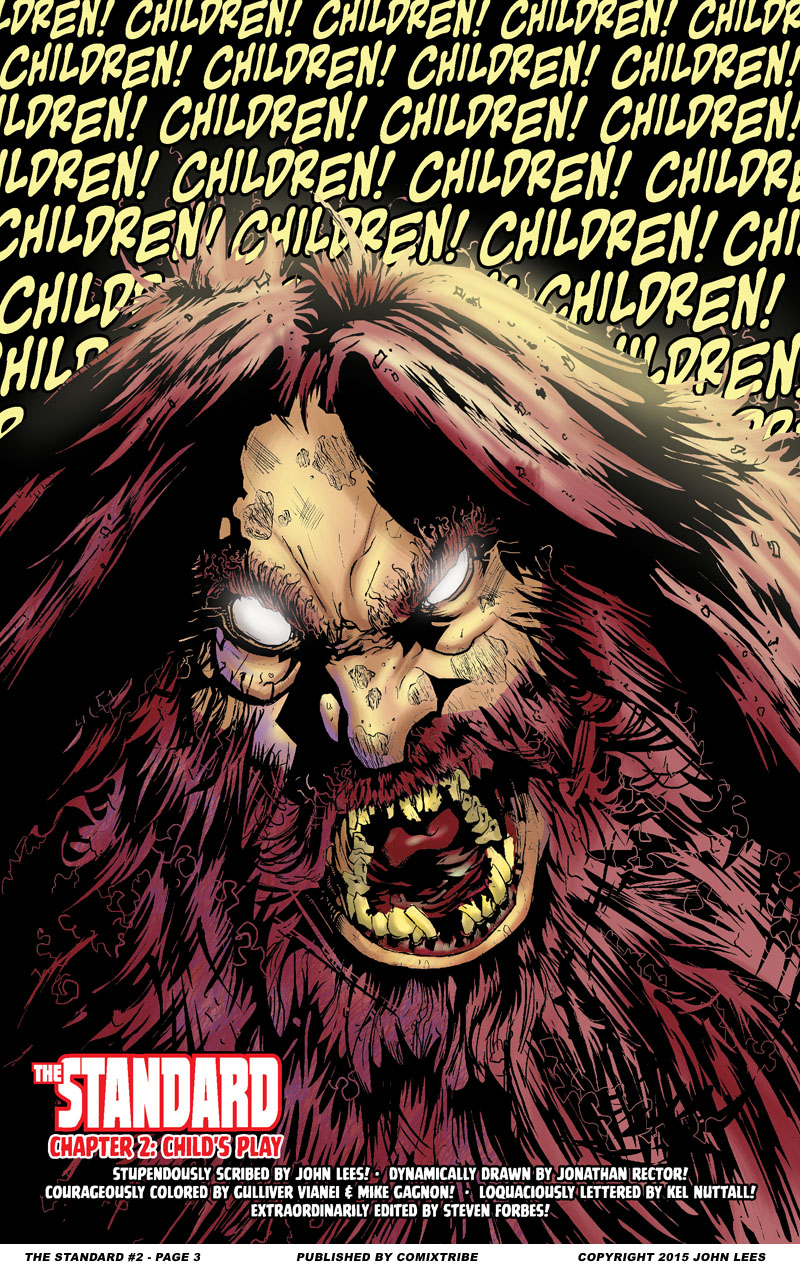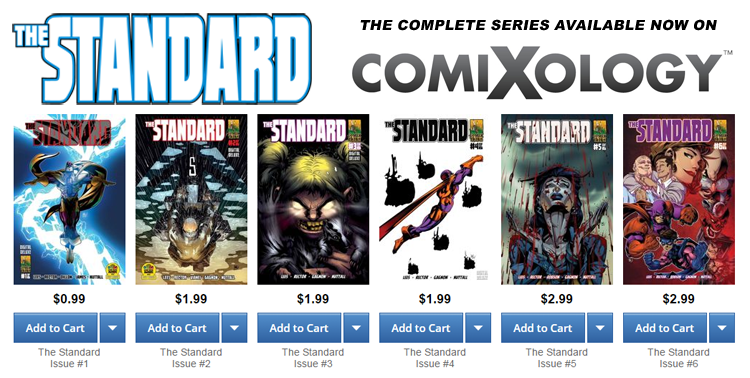The Standard #2 – Page 3
I love this page! Piper is one creepy dude, and one we’ll be seeing more of later. You might think he looks a bit like a certain famous comic creator. That would be because in the script I described him as looking like, “Alan Moore’s evil twin.”
Also, what an amazing job Kel Nuttall did on the letters here! I know the old saying goes that when a letterer is doing their job well you don’t notice them, but I really don’t give Kel enough credit for the consistently strong work he did throughout the series. But in sequences like this he gets to flex his muscles and give us letters that leap off the page.
Now, I want to follow up on something I mentioned earlier in the week. I talked about how page 1 was the last page Jonathan Rector drew on a traditional drawing board, meaning that all the remaining pages in the series going forward were drawn digitally. So, I thought I’d bring in Jon to talk a little about making the leap to digital art.
Hi Jon, and thanks for taking the time to answer some questions! THE STANDARD #2 saw you make the shift from drawing your pages on drawing boards to working digitally. What made you decide to make the leap?
Making the switch from traditional artwork (pencils, erasers, comic art board) to digital was more out of necessity than anything else. At that time, I was taking on side projects left and right. I was trying to work completely freelance, and that meant one thing; Income. As I looked around, everyone wanted their artist to be able to pencil and ink. At the time, I wasn’t that fast as a penciler, and I’d never touched proper inks in my life. Outside of Micron pens, the idea of inking entire backgrounds made me hate the entire process. I reached out to Mike Deodato over Deviantart, after finding out that a lot of his Marvel Comics work were simple pencils, tightened and darkened up in Photoshop to look like inks. This blew my mind. I used that process for the entire run on the Standard, Issue 1. My results were mixed. This is because my pencils weren’t that clean and dark, so moving into Photoshop for clean up was a chore. It added an extra 2-6 hours per page.
 After almost giving up, I eventually stumbled upon The DC Comics Guide to Digitally Drawing Comics. A godsend. Honestly, if anyone out there has any interest in making comics digitally, I personally feel this is a bible. The art style might not be your thing, and a lot of the process probably differs from how most of us work, but the nuggets of Gold that are there are real. I’ve gone back many times to that book since purchasing it back in late 2011, early 2012. I can’t praise it enough, or thank Freddie E. Williams II (the author) for writing it. Thanks Freddie!
After almost giving up, I eventually stumbled upon The DC Comics Guide to Digitally Drawing Comics. A godsend. Honestly, if anyone out there has any interest in making comics digitally, I personally feel this is a bible. The art style might not be your thing, and a lot of the process probably differs from how most of us work, but the nuggets of Gold that are there are real. I’ve gone back many times to that book since purchasing it back in late 2011, early 2012. I can’t praise it enough, or thank Freddie E. Williams II (the author) for writing it. Thanks Freddie!
Did you have reservations about switching your approach to drawing, having spent the first issue developing a style? Did you have concerns about maintaining consistency by moving to digital?
Not really. My concerns at the time were deadlines and quality. I knew if I could get close enough to how my darkened pencils turned out, I’d be OK. My biggest concern was that readers might think that it was a different artist on board (a problem that will get addressed in Issue 5). I also worried that such a drastic change in art creation, my speed would take a hit. I believe I ran that by you, and you were amazing enough to say it was OK. As for my style, it was something that would have to adapt. My needing work meant that my style couldn’t hold me back. I either had two choices, learn to traditionally ink, or learn to ink / draw 100% digital. I’ve been in Photoshop since 1998/1999, so the choice was clear.
When you first started working on pages digitally, can you remember having any difficulty in the transition? I seem to remember you struggling with some things at first.
Oh man did I ever! It was the Wild West! Everything could be perfect. Everything could be undone, and there we too many options than there should have been, with brushes and settings. I also felt like I was forcing the Freddie Method into my workflow. So there was a new learning curve added as well. It felt like starting a new job someplace. New rules and work practices, but I knew I had to keep going to see if all of this was going to pay off.
Looking back at your first digital page, are there any areas where you feel like working digitally improved the page? Would you have drawn anything differently if you’d been working on a drawing board?
My first page is actually page 3 of the Standard, Issue 2. I had asked John if I could start on this adventure with that splash page. I knew I could recoup the time it would take to pencil it, if the digital version turned out like trash. I lost my self in that splash page. Everything felt great! The initial Freddie Method workflow made my art feel ham-stringed. I really fought rushing right to inks and tapered lines. I tried to stay disciplined, but eventually I let go. I went right into a pressure sensitive brush, and was slapping blacks everywhere. Ink here, ink there. Make a new layer, drop some experimental inks there and delete. Rinse, repeat. It was an amazing adventure. If it wasn’t for that pinup and the page that followed, I’m not sure how long it would have taken to get to where I was eventually at, with a production ready work flow. It still took some time, but what it did do, was allow me to fail and win, without the fear of time.
As for the first comic page (page 2), that was another beast altogether. Looking back at that page brings back lots of memories. Working with perspective, drawing with WHITE for the first time. So much details that were lost. The work flow when working digital is crazy. Like I said earlier, you can loose yourself in it and fail a lot. I did that with both page 2 and 3. Just as when you pencil or ink in real life on paper, and see it finally printed for the first time, you don’t really know how much you should draw, and how much you should not. Details get lost when printed, and working on 300-600 DPI image files…well…that’s one heck of a lot of room to noodle in details ha ha.
Of course, one downside to moving to digital is that you no longer have physical original pages. Do you still have the original art you drew for THE STANDARD #1 and the first page of THE STANDARD #2?
I’ll have to check, I believe I do! And yes, it’s a huge let down, maybe one day. As of right now, no one has shown interest in buying pencils for the title. Perhaps one day, if I’m lucky enough to draw Superman, or the Hulk, then I’ll worry about doing legit pencils and inks for a few pages. Freddie addresses this in his comic as well, and has a great solution.
***
Thanks again for the Q&A, John! And to all my art friends out there, don’t be scared of digital! If it lets you work better and or faster, check it out. You’ll never know how much better you can be unless you try. Don’t let experimenting work new work flows deter you from your potential. Keep reading comics, and keep making comics!
Thanks to Jon for stopping by to answer some questions about his process. Fascinating reading, I’m sure you’ll agree! He’s said he’s happy to stop by and chat some more in future commentaries, so I’m sure you’ll be hearing more of his insights into the art of the story.






Discussion ¬